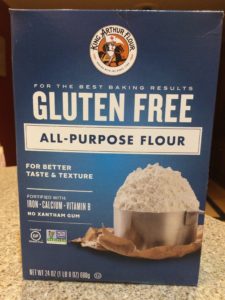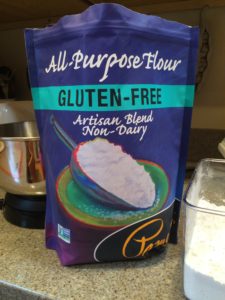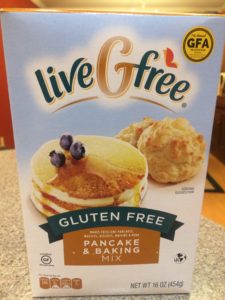Flour. Who would’ve thought that such a basic ingredient would prove to be so frustrating? You know what I mean; those of us dealing with multiple food allergies know that flour is really NOT so simple. Baking without wheat gluten (and other common binders, like eggs) requires blends of different flours and additives to make things work. Finding flour blends that mimic regular wheat flour in different types of recipes is tough and, may I add, expensive.
Do you remember Alton Brown of Food Network fame? I loved watching his cooking show because he would explain the science behind the food, like how the chemical reactions created certain flavors and textures. But us food-allergy families are always up against the science of food; how can we make allergen-free foods that look, feel, and taste like the “real” thing? But I’m no food scientist! I have a hard time wrapping my head around the reasons why certain blends work better than others. Rather, I’ve just tried various flour blends with different types of recipes (and not very methodically), and am just now coming up with a pretty reliable list of what we like best at our house. Keep in mind that these are flour blends you can buy off the grocery store shelf. Blending your own flour is certainly an option…but I’ll save that for another post. 😉
The Rundown of Flour Blends
Here’s a quick summary for you; I’ll be adding to it as we live and learn. 🙂
King Arthur Gluten-Free Flours

King Arthur Gluten Free All-Purpose Flour
King Arthur Flours are great. Their products are free of the top eight allergens and are produced in a quality controlled environment, so food allergy safety is not a concern with this brand. They have two kinds of basic flours: King Arthur Gluten-Free Flour (no thickener/xanthan or guar gum) and Gluten-Free Measure for Measure Flour (more like an all-around baking mix with xanthan gum added).
- Pros –
- This flour brand is the gold standard, as far as I’m concerned. It has a taste and texture closest to regular flour and baking. No weird aftertaste here. I’ve not had one recipe where this flour failed me, as long as you use the right flour (with our without xanthan gum) for the right recipe. 😉
- Allergen-safe – A very allergen conscience brand.
- Available at most major grocers and retailers – Around me, I can find it at Kroger, Meijer, Wal-mart (sometimes), Fresh Thyme, and of course, at the local natural grocery store.
- Cons –
- The price – There is a reason this flour is so good, I guess. 🙂 If I’m lucky and hit a sale/use coupons, I can get this flour at $5.99-6.99 per 16-24 oz box. Normal price in the Midwest seems to be between $6.50-8.00 a box for the gluten-free blend option.
- The package sizes available – I don’t know what the deal is about gluten-free flours, but manufacturers seem to think there is no market for packages of larger quantities. Maybe there are other food-science reasons, but I’m betting there is more of a cost-of-production, cost-of-marketing reason that you can only buy these products in puny 16 oz boxes or bags. King Arthur has finally started supplying larger boxes and bags of their Measure for Measure flour blend, and I’m starting to see it stocked more regularly at the bigger, more affordable retailers like Meijer and Kroger.
Pamela’s Artisan Flour Mix
I have grown to really like Pamela’s products. This company makes all kinds of flour blends and baking mixes and the products can be found almost anywhere. The flour blends and mixes have a great taste and texture, and they do seem to be allergen-conscious. The contact info for the company is easy to find on their products, and I’ve received prompt and knowledgeable responses to my emails questioning their cross-contact risk when I’ve seen a warning on their products. (They clean and sanitize between every different batch if a product is made where other common allergen products are manufactured.)

Pamela’s Gluten-Free Artisan Blend All-Purpose Flour
- Pros –
- The Artisan Flour Mix has xanthan gum added, so it is perfect for making baked goods with more heft. I love using this mix to make Izzy’s sandwich bread, for example. It is so easy because the gum is already mixed in, and the flavor is excellent. I would NOT use this flour for pancakes or muffins, though. The premixed gum means you’ll get a dense, heavy, sticky pancake, not a light and fluffy one.
- Allergy-conscious manufacturer.
- You can buy this product in a larger bag! Yassssss!
- Cost – a large bag costs $13.99-$14.99 at our local Meijer and often goes on sale. I get a lot of loaves of bread out of this baby. 😉
- Easy to find. I can get the large bag at our Meijer, Kroger (sometimes), and Fresh Thyme. I appreciate the convenience of being able to buy a larger quantity of specialty flour at a major retailer. I like to knock my shopping all out at once, you know?
- Cons –
- Hmmm… other than the fact that you can’t buy a mix without xanthan gum (which limits what you can back with this mix)…I can’t really think of any cons. We love this product!
liveGfree Gluten-Free Pancake & Baking Mix –
It’s no secret that I’m a fan of Aldi. And they do have a handful of products that we love.
One recent find is the liveGfree Pancake and Baking Mix. I’m listing it in this list of flour blends because it is a basic mix you can use for other items besides pancakes.

liveGfree Gluten Free Pancake & Baking Mix
- Pros –
- Affordable. Like pretty much everything at Aldi. Price comes in under $4.00 per 16oz (1 lb) box.
- Taste. My girls love this pancake mix, which is great when I don’t feel like whipping up one of our made-from-scratch recipes. Nice and light and NOT gummy.
- Cons –
- Not always easy to find or available. This mix seems to be fairly standard at our local Aldi at the moment, but they do rotate products a lot, or stock them sporadically. So there’s that.
- Keep an eye on the labels. Aldi’s liveGfree line is certified gluten-free, but I keep an eye on the ingredients for other allergens/cross-contact warnings every time I buy this product. (As you should do with any product, anyway, right?) At one point this product had “produced in a facility with…” warnings. Also, I used to avoid certain liveGfree mixes because some included powdered egg or soy flours, which we have to avoid.
- Not available in larger boxes or bags. What I love about Aldi is the minimalism and simplified shopping experience. What this also means is that for some products, there aren’t a lot of options (products sizes or variations) available. That’s the trade off.
Note: with the advent of increased food allergies and gluten-free trends in baking and cooking, more and more products are hitting the market every day! This is by no means a comprehensive list of all the non-wheat-based alternative flours out there. The flour blends you find and their prices may vary greatly based on where you live. These are just the main few that are readily available near me, at prices I can swallow. 🙂 If you have any recommended blends or sources, please share!
How to Learn More About Allergy-Free Flour Blends
For another resource, I’ll again recommend Colette Martin’s book, Learning to Bake Allergy Free, as she does know her food science, and explains a few basics about what works and what doesn’t in the arena of baking. Read it! It will give you more confidence, I promise. 😉

Leave a Reply